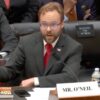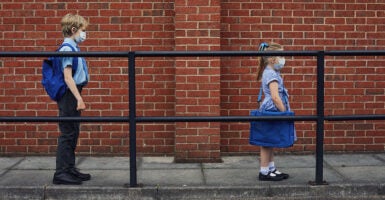What could “back to school” look like during the first fall of the COVID-19 pandemic, and what should it look like? What about an “exclusively virtual” education experience? What are wise precautions to take and what is unrealistic? Lindsey Burke, who directs The Heritage Foundation’s Center for Education Policy and is the think tank’s Will Skillman fellow in education, joins the podcast to discuss.
We also cover these stories:
- Seventeen states plus the District of Columbia are taking President Donald Trump’s administration to court.
- Tensions between the U.S. and China continue to escalate, with China putting sanctions on Sens. Ted Cruz of Texas and Marco Rubio of Florida, both Republicans.
- The Washington Redskins have thrown out both their team name and logo.
“The Daily Signal Podcast” is available on Ricochet, Apple Podcasts, Pippa, Google Play, and Stitcher. All of our podcasts can be found at DailySignal.com/podcasts. If you like what you hear, please leave a review. You can also leave us a message at 202-608-6205 or write us at [email protected]. Enjoy the show!
Rachel del Guidice: I’m joined on The Daily Signal Podcast today by Lindsey Burke. She’s the director of the Center for Education Policy and a Will Skillman fellow in education [at The Heritage Foundation]. Lindsey, it’s great to have you on The Daily Signal Podcast.
Lindsey Burke: Thanks for having me.
Del Guidice: So with the recent rising numbers we’ve seen out of places like Florida and Arizona and Texas and California, what do you think back to school is going to look like for students in the coming weeks as we get closer and closer to August?
Burke: Well, what it should look like is schools, to the best that they can, should reopen. That of course should take into account the local context, local conditions on the grounds, but if they can, they should certainly strive for reopening in the fall.
Unfortunately, I don’t think that’s what we’re going to see in a lot of instances. I was more confident this morning, actually, but just before coming on this podcast, the Los Angeles Unified School District, which is the second-largest school district in the entire country, announced that they will not be reopening in-person this fall. So that’s a big deal.
There are between 600,000 and 700,000 students who are in LA Unified, and I think it could really portend things to come in the fall for a lot of districts. Hopefully it doesn’t, hopefully we will see more districts moving toward reopening quicker, but that is the news on the ground today is LA Unified will not be reopening.
Del Guidice: You mentioned … LA, they’re going to stay closed. What about other states across the country? How are they addressing this? Are they going to be reopening? Or are they going to be doing some in-person, some online? What does it look like for other states so far?
Burke: Well, for the most part local school districts, we’re still sort of in that waiting period to see what they do, but we’re getting really close, I think, over the next week or two, to seeing just a massive amount of announcements one way or the other.
If you look at Fairfax County in Virginia and other large school districts, they were one of the first out of the gate to release what their plan would be for the fall. They’re giving parents an option of either online or some mix of in-person and online in their school districts.
So I think in short order, we’re going to see a lot of states and districts start to make that announcement. But right now we’re still at the point where we haven’t seen a ton release those plans yet.
Del Guidice: CNN has reported over the weekend that internal documents in the U.S. Centers for Disease Control and Prevention warn that fully opening K-12 schools and universities would be the highest risk for the spread of the coronavirus, and they’re citing a New York Times report in CNN’s reporting. Would you say reopening schools is a right risk to take?
Burke: I think that, again, we really need to think about the local conditions on the ground. It might be the right call in one area, but another area they have an outbreak might need to hold off a little bit.
I think what is instructive, though, at the moment is to look at what schools around the world have started to do, what countries around the world are doing when it comes to their school reopening.
Science Magazine, of course, well-respected publication, they looked at over 20 countries that had reopened since June, and a lot of those countries throughout Europe, but they really decided that their reopening would happen because children in particular, we know it is rare for children to develop really severe symptoms, and if they contract the virus, it seems rather rare for them to spread it if they do get it. So that was the assessment in Europe for a lot of the schools that reopened in countries across the Continent there.
So that could be instructive, but at the end of the day, it really is going to come down to local leadership. It should be a conversation between parents and between their local school.
Right now, what we’re seeing, I think, unfortunately, is a conversation that is looking increasingly to Washington to provide the answers. And that of course is moving it further and further away from the people, the children that these decisions are going to impact.
So right now we see special-interest groups, the teachers unions are calling for hundreds of billions of dollars in new money to be spent at the federal level in order for schools to reopen. The administration, President [Donald] Trump has said the opposite, that schools should not get federal funding if they don’t reopen.
Then the education secretary, Secretary [Betsy] DeVos, has said, well, maybe not cut off funding, but allow those dollars to follow students to schools of choice that are open.
I think that really should be our posture with regard to federal policy and federal spending, that if schools aren’t going to reopen, let’s fund the student and allow those dollars to follow that student to schools of choice that are open.
Del Guidice: Lindsey, you had briefly mentioned Europe, and what does back to school look like on the international front? How are other countries handling their schools?
Burke: Well, a lot of schools, a lot of countries throughout Europe have opened schools, at least partially, throughout the spring.
So Denmark, for instance, was the very first country in Europe to reopen schools. They reopened their schools all the way back, it seems like a million years ago, but all the way back in April, April 15, and their approach is to do as much in terms of class time as they can outside.
They also divide children into small groups. This is apparently the new education buzzword now. They divide them into pods. So kids are in pods of about 12 students.
Finland reopened schools in May. They retained their existing class size, so they didn’t reduce class sizes. That’s something that we’ve heard calls for here, but they’ve kept classes separated from each other. They’ve done a staggered reopening by age.
If you look at France, France schools reopened mid-May there, but they reopened on a voluntary basis. So it depends. It’s very country-specific.
Germany opened schools on a part-time basis. If you go outside of Europe, if you look at places like Japan right now, in Japan, again, they’re reopening process in June. So just last month they started reopening schools and they have some pretty clear-cut guidelines for what they expect of the families once schools reopened.
So parents have to take their child’s temperature every morning and they report their temperature to the school before they show up that morning. Children attend school on alternative days. So they alternate days back and forth. Teachers and kids wear masks. So it just really depends.
Then you have the other side of the spectrum, which are the countries that never closed schools at all, right? Sweden never closed down its schools from Day One of the pandemic. So that’s the other end of the spectrum there.
Del Guidice: Going back to the U.S., one of the political debates right now is whether schools should follow the CDC guidelines. What do you think? And … what are some of those guidelines?
Burke: I think it is really locally-driven and should be locally-driven and context-specific. This is something that the National Coronavirus Recovery Commission, [which] The Heritage Foundation launched, [recommended], was that that decision does stay local.
The CDC has recommended things like sanitizing the playgrounds in between each use. Of course, social distancing of students there. To some extent alternating days, or at least classes that go back to school. I think the answer there really has to be whatever works in a local context. That’s something that school leaders are thinking hard about across the country.
That’s something we have a lot of evidence to from the nonpublic sector, from the private school sector, and in some instances from some of our friends in the online space and the charter school space, that it really is school dependent, that school leaders are thinking deeply about what those reopening plans look like. They are really starting to think through, “What does an emergency management plan look like for my school, if it has to close again?”
This is something else that has come out of Europe too. Instead of just shuttering schools across the board, that once schools did reopen, if there was a teacher or a student who contracted the virus, to not necessarily close down the entire school, but to have that student go home, to not reenter school for a period of two weeks or whatever it might be. But only if you get a certain number of cases growing to shut down that school.
So, again, it’s really going to need that local context, a state to state and even district to district. But as I said a minute ago, right now, so much of the focus has started to shift toward Washington, right?
We saw the education secretary this weekend was on TV, a couple of different media hits over the weekend, talking about school reopening. But I think she really hit the nail on the head with that when she said that those dollars that we currently spend should follow kids to schools of choice that are open. So that’s I think what we have to keep front and center.
If a family is not satisfied with how a school proposes to reopen in the fall, what that school’s plan might look like, they should be able to take their dollars to an education environment that reflects what they want for their child, the day-to-day experience that they want their child to have in this post-pandemic era that we’re approaching.
Del Guidice: Lindsey, as you’ve looked through guidelines and seen what some districts are looking at versus others, what are some good precautions that you’ve seen that you would like to just share with others and then others that you’ve seen that just seem unrealistic or could be approached in a better way?
Burke: … When you talk to school leaders across the country, I think everybody sort of gets it intuitively. But the thing that you hear school leaders say is that it could be difficult among very young children, right?
Think about kids who are in kindergarten, to have them potentially wear masks all day, or to really enforce some of that social distancing. That’s not to say one way or the other that that’s the right policy or the wrong policy, just when you listen to school leaders across the country, that is one concern that they have is with that, the really, really young kids have some of the enforcement pieces there.
Then you hear some of the same concerns when it comes to things like sanitizing the playground in between each use, that that’s something that might be difficult for schools to do. Again, not a comment on whether or not that’s good or bad policy, but something that we’re hearing.
In our world, the thing that I think has really been striking more so than how schools are really thinking about sort of the health perspective of reopening has been the extent to which they have or have not provided access to instructional material. I mean, it has been just all over the place in terms of what district schools in particular have been doing since March, since schools closed.
About a third of districts across the country of those districts that have been studied have really provided virtually no online instruction to speak of. That has been and I think will prove to be a real loss for a lot of students across the country.
Then we see about a third that are doing a pretty decent job providing online instruction, but they’re not taking attendance of students. They’re not grading student work. So how much will that really, I think, benefit the student long term is an open question as well. If they’re providing that online and instruction, but not monitoring student progress, what does that mean long term?
Then we’ve got about a third of districts who’ve done a pretty good job overall at providing online options, but it has been spotty across the country.
I will say too that this is why it’s so important to make a distinction when it comes to online learning between districts, public school districts that have had to, in some cases, haphazardly put together an online platform for their instruction and give it to students virtually versus students who chose to learn online before the pandemic hit. There’s a big difference there.
Families who selected into an online learning option pre-pandemic versus what we’re seeing [right now, … which is this sort of accidental homeschooling. We’re all homeschoolers now [in this] moment that we’re in. So just a little caveat there.
Del Guidice: On that note, my next question fits in perfectly. Just to talk about this more virtual experience, that probably a lot of people in LA will end up having to become part of, … what would an exclusively virtual experience look like as some school systems are proposing just that?
Burke: Yeah, so, it’s going to vary, I think, widely by district, if history is any indication and recent history … since the pandemic started because it really has been all over the map, the extent to which districts are providing high quality of virtual instruction to students.
But I can tell you what it tends to look like. In some cases it will be at the beginning of the week, the district will provide some number of hours, three hours perhaps, of instructional material for a student to work through.
Some districts are doing a good job with that synchronous online option, where you have a teacher in front of the students, they’re in a virtual classroom, they’re learning together about as close as you can model to that sort of typical, traditional in-person classroom experience.
So it tends to be something along those lines where you have the districts, where you have a local school providing some amount of content on the front end for students to work through.
The real variable in that equation is the extent of time that they are spending sort of face to face online with a teacher, and that has been really all over the place.
Del Guidice: Lastly, Lindsey, how would you say this long-term quarantine and lack of programming for young people and students, whether it’s school camps over the summer, how has that had an effect on students and what especially about those students who are low income in particular?
Burke: Yeah. You know, this is the big, big question. It’s the big important question: To what extent are we really going to see a negative impact on student learning as a result of schools being closed?
If you look at a district like LA Unified, which, again, has just announced that they’re not reopening this fall, they have reading proficiency rates among their eighth-grade students of 18%. So 18% of eighth-graders in LA Unified, the second-largest school district in the country, can read proficiently. I mean, that should keep us all up at night.
I say that because there are, and so many people are well aware of this through firsthand experience, so many instances where children are already not getting access to quality content, that their traditional district school for whatever reason is not meeting their needs.
We know across the country nationally only about one-third of students can read proficiently. So LA is even more of a exclamation point behind that low level of reading proficiency.
So the question really is, what does it look like [over the] next year or two years later or once we really start to get the data in on the impact that this has had on student learning?
I think for low-income students in particular, we’re probably going to see a negative impact on their student learning outcomes. But the district system has had a long way to go before this pandemic hit anyways. So it will, I think, be interesting just to know those baseline numbers, right? To know that only a third of kids were proficient in reading before the pandemic hit. Then to really be able to put into context what the numbers look like a year or two from now.
… The absolute best thing that we could do right now would be to give families control over the money that is being spent on schools they cannot physically enter.
We are funding schools like LA Unified, the doors are shut. Parents cannot get into them. Those parents should be able to take their dollars to schools that they want to attend, that will meet their child’s needs, that are actually open, where the doors are open, or they should be able to use them for virtual tutors or online learning, whatever it is that meets their child’s unique learning needs.
So we have said that states immediately should move toward providing emergency education savings accounts for families. It’s a really smart targeted response to this pandemic that I would argue is also a very good long-term policy.
Del Guidice: Lindsey, thank you so much for breaking the sound for us today on The Daily Signal Podcast. We appreciate having you with us.
Burke: Thanks for having me.































